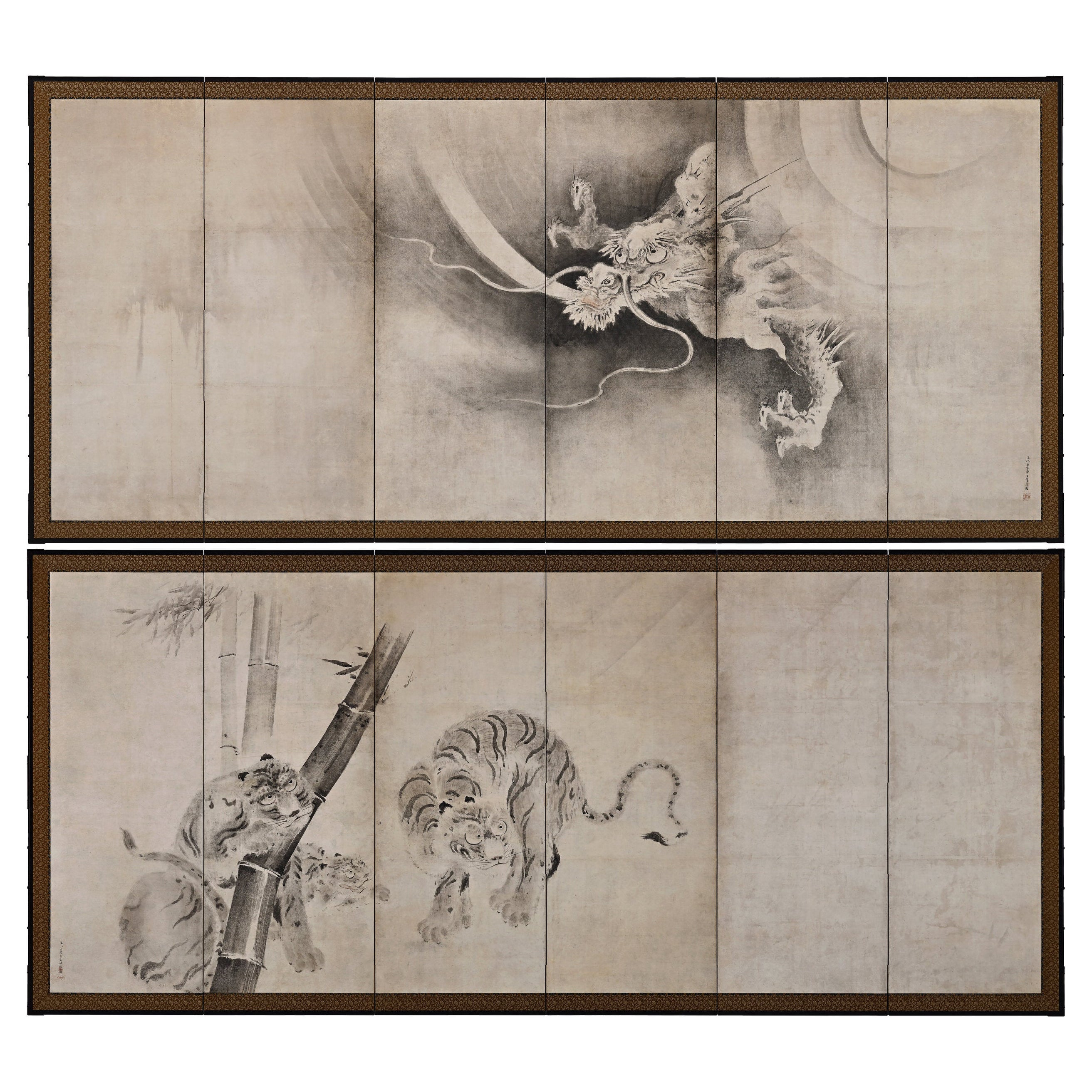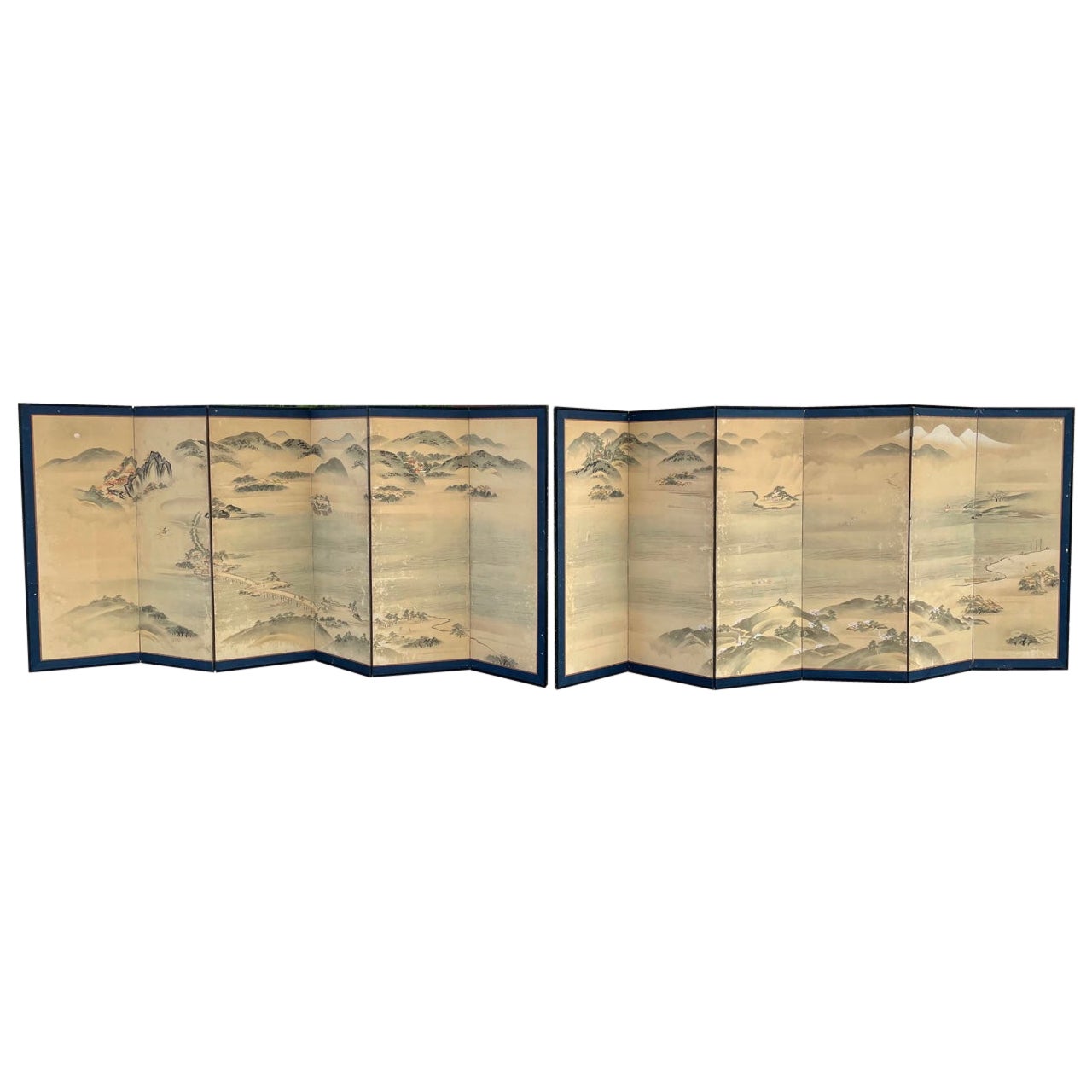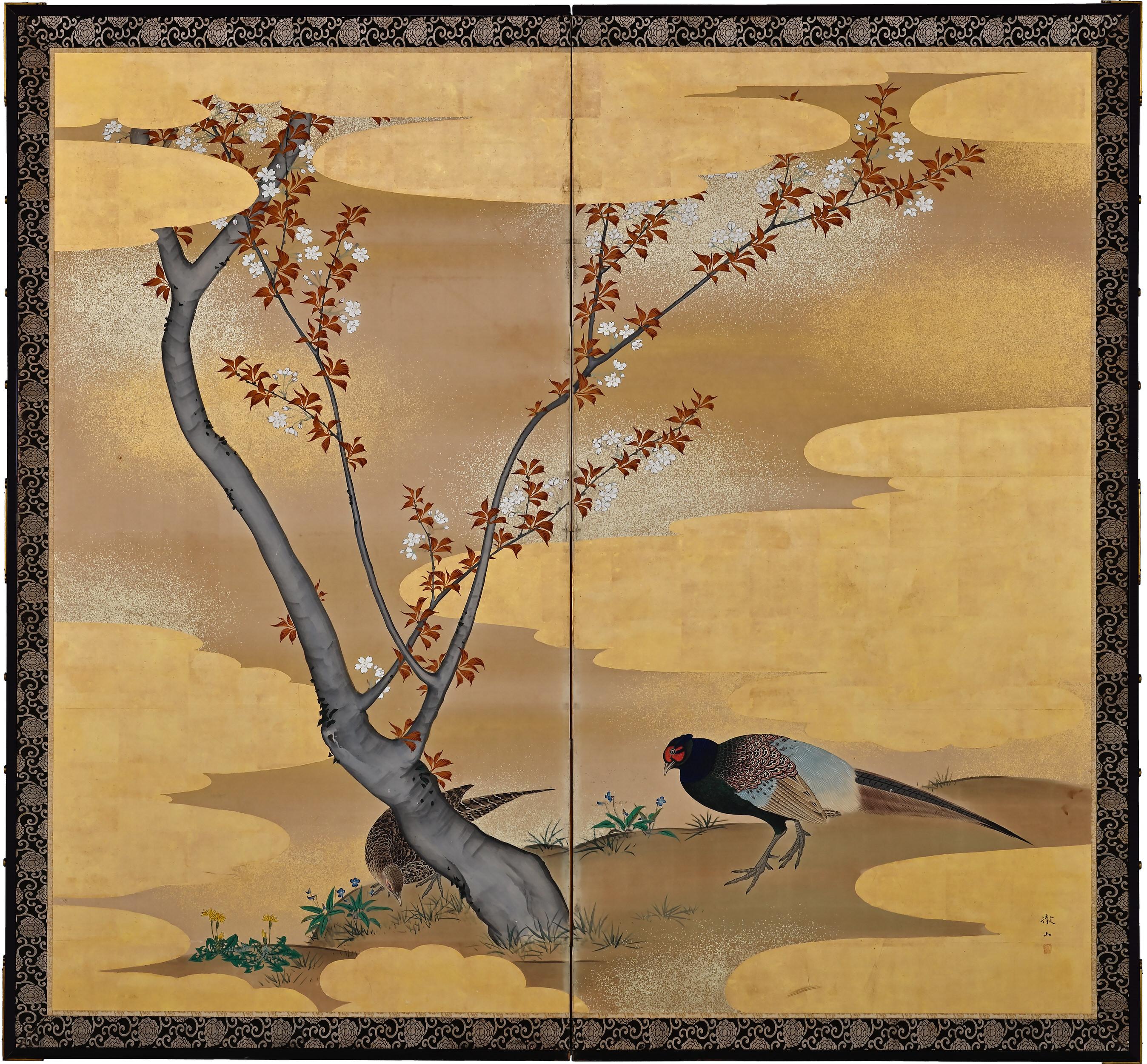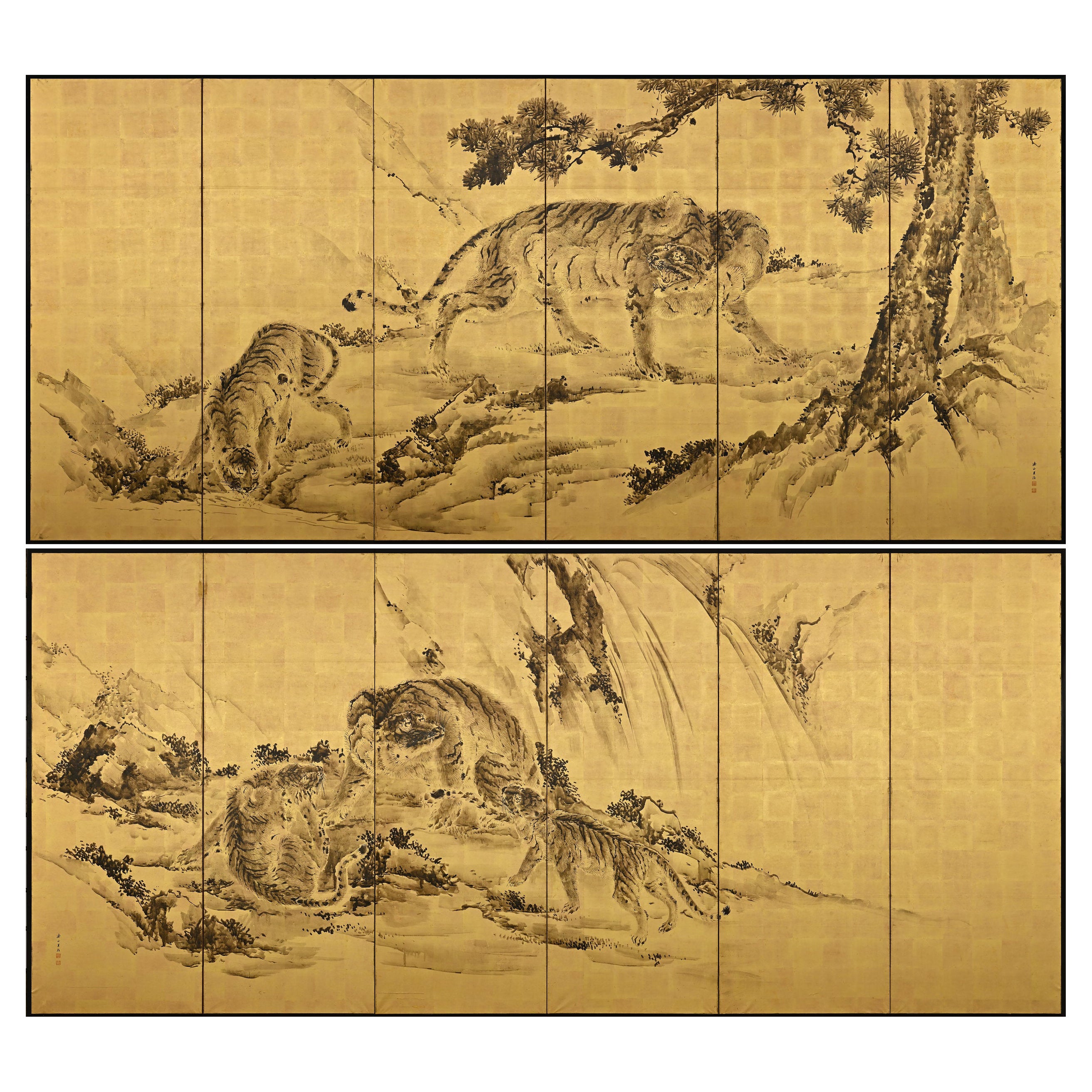Items Similar to 19th Century Japanese Screen Pair. Tiger & Dragon by Tani Bunchu.
Want more images or videos?
Request additional images or videos from the seller
1 of 11
19th Century Japanese Screen Pair. Tiger & Dragon by Tani Bunchu.
About the Item
Tani Bunchu (1823-1876)
Tiger and Dragon
A pair of six-panel Japanese screens. Ink on paper.
In this grand pair of Japanese Ryuko-zu screens the tiger crouches low to the ground, a sign that the yin earth is the tiger’s territory. Bamboo bends in the force of the wind, said to be created by the tiger’s mighty roar. The tiger’s strength is a quiet power, held in its coiled posture. The dragon, on the other hand, is full of active energy. It emerges out of the yang heavens. Its energy causes rain clouds to swirl and whips the water below into wild waves. The tiger and dragon are ancient symbols of yin and yang, forces that combine to make up the universe.
Japan’s early artistic treatment of tigers is usually highly stylized and this example by Tani Bunchu is no exception. With no indigenous specimens to study, artists of the pre-modern period constructed their notions of the tiger from skins imported into the country. This has resulted in a rather cat-like depiction of this noble creature, capturing the essence of the animal rather than striving for realism. The Japanese dragon, like its Chinese ancestor, is an ancient mythical creature that is very different from its malevolent, treasure-hoarding Western equivalent. The Asian dragon’s origin predates written history, but had achieved its present form of a long, scaled serpentine body, small horns, long whiskers, bushy brows and clawed feet by 9th century Tang ink painting. By this time it was part of Buddhist mythology as a protector of the Buddha and Buddhist law. These traditions were adopted by the Japanese and the character for dragon is much used in temple names. In painting for the Japanese Zen sects, especially, depictions of dragons and tigers were frequently paired and appeared often on the walls and screens of monastic dwelling chambers. The motifs spread from Zen circles into the secular world and especially appealed to the military classes, tigers serving also as symbols of strength and virility.
Tani Bunchu (1823-1876) was a painter of the Tani Buncho school. He learned painting techniques from his father, Tani Bunji (1812-1850), and was an active painter in Edo and Tokyo from the end of the Edo period to the Meiji period. Tani Bunji succeeded his father Tani Buncho (1763-1840) as head of the family. Bunji passed away at the young age of 38, and there are only a few paintings left by him. Tani Buncho was a highly eclectic and influential painter working in Edo in the late 18th and early 19th centuries, who mastered a wide variety of historical painting styles from China and Japan.
- Dimensions:Height: 70.5 in (179.07 cm)Width: 144 in (365.76 cm)Depth: 0.75 in (1.91 cm)
- Sold As:Set of 2
- Style:Edo (Of the Period)
- Materials and Techniques:
- Place of Origin:
- Period:
- Date of Manufacture:Circa 1850
- Condition:Refinished. Wear consistent with age and use. This pair of screens were remounted and restored at some stage during the first half of the 20th century.
- Seller Location:Kyoto, JP
- Reference Number:1stDibs: LU2472339757662
About the Seller
5.0
Recognized Seller
These prestigious sellers are industry leaders and represent the highest echelon for item quality and design.
Gold Seller
These expertly vetted sellers are highly rated and consistently exceed customer expectations.
Established in 2001
1stDibs seller since 2016
62 sales on 1stDibs
Typical response time: 6 hours
- ShippingRetrieving quote...Ships From: Kyoto, Japan
- Return PolicyA return for this item may be initiated within 10 days of delivery.
More From This SellerView All
- 17th Century Japanese Screen Pair. Tiger & Dragon by Kaiho YusetsuLocated in Kyoto, JPKaiho Yusetsu (1598-1677) Tiger and Dragon Early Edo Period, Circa 1650 A Pair of Six-fold Japanese Screens. Ink and slight color on paper. Dimensions: Each screen: H. 171 cm x W. 380 cm (67.5’’ x 149.5’’) In this pair of early Edo period Japanese screens a group of tigers prowl in a bamboo grove whipped with fierce wind, while a dragon claws through clouds and mist. The dragon embodies elemental qualities - looming out of the mist, the coils of its body disappearing in the clouds. The dragon is calling for rain, symbolizing spring which is considered the fountain of life. On the other side, the tigers calls for the wind, symbolizing autumn which is considered the end of life. Tigers were familiar motifs within Japanese art from ancient times though the animals were imaginary to the people in the 17th century. While dragons and tigers are usually associated as sacred and ferocious, in this painting, both animals have rather amusing expressions. The tigers appear to glare at the dragon with cat-like eyes, and the look on the swirling dragon’s face appears almost affectionate - lending a playful flair to an otherwise magnificent theme. The tiger and dragon are cosmological symbols of the balancing forces in the world. Screens such as this were originally meant to express the fluctuating nature of the world. For Japanese in the early Edo period, they likely suggested the powers of the cosmos. In Japan the tiger and dragon motif was originally absorbed into the circles of Zen monasteries before spreading into the secular world. The theme especially appealed to the military classes with the Kano school, the official painters to the Shogun and the samurai, being the leading contributors. The painter of this pair of screens, Kaiho Yusetsu (1598-1677), was closely patronized by the third Shogun Tokugawa Iemitsu. In his later years he worked with Kano school artists...Category
Antique Mid-17th Century Japanese Edo Paintings and Screens
MaterialsSilk, Wood, Paper
- Japanese Screen Painting, Early 19th Century, Autumn Flowers by Sakai HoitsuLocated in Kyoto, JPA two-fold Japanese screen by the Rimpa school artist Sakai Hoitsu (1761-1828), Japan, 19th century, Edo period. This small Japanese folding screen pai...Category
Antique Early 19th Century Japanese Edo Paintings and Screens
MaterialsWood, Silk
- Early 19th Century Japanese Screen. Cherry Blossom & Pheasants by Mori TetsuzanLocated in Kyoto, JPMori Tetsuzan (1775-1841) Pheasants and Cherry Blossoms Two-fold Japanese screen. Ink, color, gofun, gold and silver on paper. A two-fold Japanese bir...Category
Antique Early 19th Century Japanese Edo Paintings and Screens
MaterialsGold Leaf
- Japanese Screen Pair, Tigers by Kishi Renzan, Late Edo PeriodLocated in Kyoto, JPKishi Renzan (1804-1859) Tigers Pair of six-panel Japanese screens. Ink and gold-leaf on paper. In this monochromatic pair of six-fold Japanese screens painted on gold-leaf, Kishi Renzan has created a breathtaking composition of a family of tigers. The screens are filled with a sense of drama which is conveyed by both the subject matter and the wet, expressive brushwork. The running mountain stream and the towering waterfall allude to refreshment during the summer months and we feel the tiger families familiarity and security within their environment. Renzan’s master, Kishi Ganku...Category
Antique Mid-19th Century Asian Edo Paintings and Screens
MaterialsGold Leaf
- 17th Century Japanese Screen Pair, CranesLocated in Kyoto, JPCranes Anonymous, Kano School. Edo period, second half of the 17th century. Pair of six-panel screens. Ink, pigment gofun and gold l...Category
Antique 1670s Japanese Edo Paintings and Screens
MaterialsGold Leaf
- 19th Century Japanese Screen, Deer in Spring, Maruyama Shijo SchoolLocated in Kyoto, JPA six-panel Japanese folding screen from the leading Maruyama-Shijo artist Okamoto Toyohiko (1773-1845). Simply featuring three deer and a few sprigs of foliage on a sumptuous gold-leaf background this work emphasizes naturalistic expression and a masterful use of negative space. Reduced to its most basic elements, the blank spaces inspire imagination and evoke the smells, sounds and even the weather of the scene. Whilst deer are traditionally depicted in association with autumn, here the green growth on the tops of the foliage indicates the season of spring. The work references Maruyama Okyo’s two-panel deer screen...Category
Antique Early 19th Century Japanese Edo Paintings and Screens
MaterialsGold Leaf
You May Also Like
- Pair of 19th Century Japanese ScreensLocated in Bagshot, GBA pair of large 19th century Japanses Screens of Japanese scenery. The screens also come with a wooden crate which would have been built for them at a later date in order to move ...Category
Antique 19th Century Asian Other Decorative Art
MaterialsPaper
- 19th Century Japanese Edo Screen Kano School Garden TerraceLocated in Rio Vista, CAFantastic 19th century Japanese Edo/Tokugawa period two-panel byobu screen featuring Chinese children frolicking on a garden terrace with a pavilion and large pine tree. Made in the ...Category
Antique 19th Century Japanese Edo Paintings and Screens
MaterialsBrass, Gold Leaf
- 19th Century Japanese Edo Six Panel Kano School Landscape ScreenLocated in Rio Vista, CALate Edo period 19th century Japanese six-panel landscape screen featuring a cypress tree over a flowering hibiscus with a pair of hototogisu birds. Kano school painted with ink and ...Category
Antique 19th Century Japanese Edo Paintings and Screens
MaterialsSilk, Wood, Paper
- Pair Large Framed Japanese Calligraphy "Dragon" & "Tiger", Mid 20th CenturyLocated in Austin, TXA large and powerful pair of Japanese calligraphic works, mid 20th century, Japan. One reading "Dragon", the other reading "Tiger". Ink on handmade paper, framed. The brush strok...Category
Mid-20th Century Japanese Expressionist Paintings and Screens
MaterialsPaper
- 19th Century Japanese Gold Falcons Folding ScreenLocated in London, GBJapanese four-panel screen, decorated with tamed perching falcons (Shōgun’s pets) on a gold background. Japanese falconry, or takagari, was a sport of aristocrats such as nobles and...Category
Antique 19th Century Japanese Paintings and Screens
MaterialsSilk, Wood
- Japanese Six Panel Screen with Hotei, Edo Period, Early 19th CenturyLocated in Austin, TXA delightful Japanese six panel painted paper screen featuring the beloved figure Hotei, Edo Period, early 19th century. Hotei, called Budai in China, and known as the Laughing Buddha or Fat Buddha in the West, is considered to be an emanation of Maitreya, the Buddha of the Future. In Japan, he also holds a special place as one of the Seven Lucky Gods, being the god of fortune, and protector of children. He is always portrayed as a mirthful and corpulent man, dressed in loose robes that show off his round belly. He carries a sack with him, said to be filled with treasure. As the protector of children, he is often portrayed with them playing on or around him, as he is here. The children portrayed in this screen are dressed in Chinese style clothing...Category
Antique Early 19th Century Japanese Edo Paintings and Screens
MaterialsSilk, Paper
Recently Viewed
View AllMore Ways To Browse
The Tiger
Mid Century Modern Screen
Midcentury Modern Screen
Wood Screens Modern
Japanese Mid Century Wood
Mid Century Japanese Paper
Antique Creature
9th Century
Mid Century Modern Japanese Style
Japanese Zen
Low Screen
The Antique Tiger
Wood Dragon
Antique Chambers
Tiger Woods
Dragon Japan
Japanese Dragon
Japan Hand Painted China





